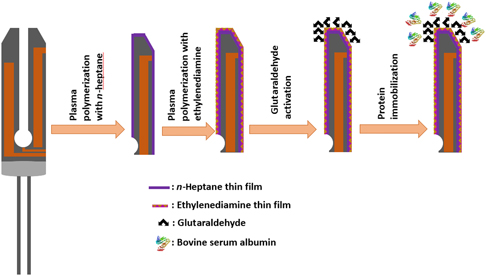Crossref Citations
This article has been cited by the following publications. This list is generated based on data provided by
Crossref.
KALELİ CAN, Gizem
MUTLU, Selma
and
MUTLU, Mehmet
2019.
Plasma Polymerized Films for Mass Sensitive Biosensors.
Natural and Applied Sciences Journal,
Vol. 2,
Issue. 1,
p.
1.
Alshammari, Abeer
Aldosari, Fadwa
Bin Qarmalah, Najd
Lsloum, Ahoud
Muthuramamoorthy, Muthumareeswaran
and
Alodhayb, Abdullah
2020.
Detection of Chemical Host–Guest Interactions Using a Quartz Tuning Fork Sensing System.
IEEE Sensors Journal,
Vol. 20,
Issue. 21,
p.
12543.
Kaleli-Can, Gizem
Özgüzar, Hatice Ferda
and
Mutlu, Mehmet
2021.
Development of mass sensitive sensor platform based on plasma polymerization technique: Quartz tuning fork as transducer.
Applied Surface Science,
Vol. 540,
Issue. ,
p.
148360.
Demir, Derya
Gundogdu, Sude
Kilic, Seyda
Kartallioglu, Tugce
Alkan, Yusuf
Baysoy, Engin
and
Kaleli Can, Gizem
2021.
A Comparison of Different Strategies for The Modification of Quartz Tuning Forks Based Mass Sensitive Sensors Using Natural Melanin Nanoparticles.
Journal of Intelligent Systems with Applications,
p.
128.
Parmar, Saurabh
Ray, Bishakha
and
Datar, Suwarna
2021.
Detection of binary and ternary mixtures of volatile organic compounds using quartz tuning fork based sensor array.
Sensors and Actuators A: Physical,
Vol. 332,
Issue. ,
p.
113198.
Özgüzar, Hatice Ferda
Meydan, Ahmet Ersin
Göçmen, Jülide Sedef
and
Mutlu, Mehmet
2021.
Single-step amphoteric surface modification through plasma polymerization: Antifouling coating for titanium substrate.
MRS Communications,
Vol. 11,
Issue. 4,
p.
523.
Kaleli-Can, Gizem
Özgüzar, Hatice Ferda
and
Mutlu, Mehmet
2022.
Development of QTF-based mass-sensitive immunosensor for phenylketonuria diagnosis.
Applied Physics A,
Vol. 128,
Issue. 4,
Özgüzar, Hatice Ferda
Evren, Ebru
Meydan, Ahmet Ersin
Kabay, Gozde
Göçmen, Julide Sedef
Buyukserin, Fatih
and
Erogul, Osman
2023.
Plasma‐Assisted Surface Modification and Heparin Immobilization: Dual‐Functionalized Blood‐Contacting Biomaterials with Improved Hemocompatibility and Antibacterial Features.
Advanced Materials Interfaces,
Vol. 10,
Issue. 6,
Erbaş, Kadir Can
Erdoğan, Mebrure
Çökeliler Serdaroğlu, Dilek
and
Koçum, İsmail Cengiz
2024.
A game-changing equation during the etching of tuning forks and its verification through experiments.
Measurement,
Vol. 237,
Issue. ,
p.
115135.
Gürcan, Dilhan
Baysoy, Engin
and
Kaleli-Can, Gizem
2024.
Anti-IgG Doped Melanin Nanoparticles Functionalized Quartz Tuning Fork Immunosensors for Immunoglobulin G Detection: In Vitro and In Silico Study.
Sensors,
Vol. 24,
Issue. 13,
p.
4319.
KALELİ CAN, Gizem
2024.
Molecularly Imprinted Chitosan Modified Quartz Tuning Fork Sensors for Real Time Biosensing in Liquid Environment.
Düzce Üniversitesi Bilim ve Teknoloji Dergisi,
Vol. 12,
Issue. 1,
p.
337.
Alzahrani, Khalid Y.
Alfifi, Yasmin A.
Ghneim, Hazem
Assaifan, Abdulaziz K.
Al-Gawati, Mahmoud
Albrithen, Hamad
Alsheikh, Yazeed
and
Alodhayb, Abdullah N.
2025.
Development of a novel latent deoxyribonucleic acid detection technique for crime scene investigation using quartz tuning fork-based biosensor technology.
Forensic Science International,
Vol. 367,
Issue. ,
p.
112360.
